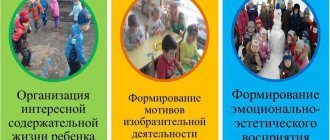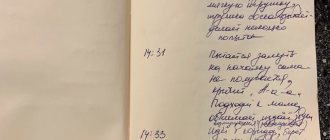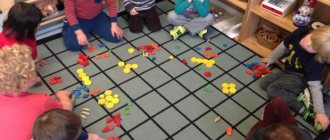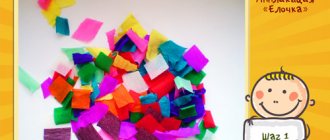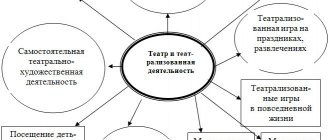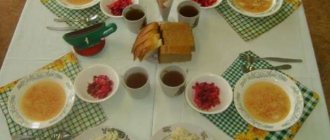Progress of the game:
Children should stand in single file
, holding onto the belt of the person in front.
The teacher blindfolds them and leads them along a certain route, overcoming an “obstacle course.”
(stepping over stones, going around trees, passing low under a lowered branch, etc.). The route is outlined by the teacher in advance and it is better if it goes in a circle. Having reached the beginning, the teacher unties the children's eyes and invites them to go through the same route with their eyes open, without holding on to their belts, in order to be able to look and touch what the teacher told them while going through the obstacle course, but which they themselves did not see. Let the children themselves try to guess where they bent down and where they walked around the stone.
OUTDOOR GAMES “FIND YOUR TREE”
Goal: to provide the opportunity to explore the environment , to use the experience of direct communication with it (carried out in nature)
.
Progress of the game:
Option 1.
All the birds are playing, one child is an owl, which is located on the side of the playground. On the signal "day"
the birds fly away, flap their wings, and peck at the grains.
At the signal “night”
everyone stops and stands
motionless . An owl flies out, looks out for those who move and takes them into the nest. in 15-20 seconds. “day”
signal is given again , the owl flies to the nest, and the children - birds fly around the playground.
Option 2.
Two owls are selected. Take interesting poses.
"Horses"
Goal: to teach children to run, raising their knees high in pairs, without bumping into each other, to perform movements in accordance with the text. Develop coordination of movements, the ability to play in pairs.
Progress of the game:
Children should be divided into two teams: “Owls”
and
"Crows"
. Both of them stand in a line opposite each other at a distance of 3 meters, behind them are their houses, also at a distance of 3 meters. The teacher gives the task:
"Owls"
love the truth,
the Ravens
love lies, so if I tell the truth,
the Owls
must catch
the Ravens
.
"Crows"
run away to their homes and vice versa.
Then the teacher pronounces phrases of natural history content:
bears love to eat tigers
birch trees have earrings in spring
elephants can't swim
dolphin is an animal, not a fish
Children must realize the correctness or incorrectness of the phrase, based on their knowledge on this topic, and react with their own behavior (run away or catch up)
to this phrase. After each time, it is advisable to ask the children why they acted one way or another, and after 2-3 phrases, change the players’ places.
"Owl"
Goal: to teach children to run scattered around the playground, pretending to be birds, and take a static position when given a signal. Develop the ability to act on a signal and imagination. Change movements.
Action and story games
Author: Pivnyk Yulia Yurievna
MOVEMENT AND STORY-STAGED GAMES
It is very important at an early stage of childhood to lay the foundations of positive artistic perception, to raise our kids to be dexterous, smart, cheerful and sociable. Games solve these problems perfectly, you just need to follow the principle: do not focus children’s attention on leadership, instill in them a taste not for the result, but for the process itself. Games are also necessary in the classroom as an element of relaxation: relax, exercise, have fun. At the same time, they can serve as a powerful incentive - “You worked out well, now you can play!”
Some games such as “Spider and Flies”, “Frogs and Heron”, etc., are essentially skits where everyone plays their role. In this case, what is important for the teacher, and what is interesting for the children, is images, plasticity, facial expressions, and the goal of catching up or hiding becomes conditional.
In the games “Train”, “Brave Rider”, etc., to some extent, there is a spirit of competition, and here the teacher should smooth out this moment, paying more attention to the children’s correct execution of movements, the ability to hear music, navigate, act according to the idea, figuratively.
In the games “I am an artist”, “Cinema-photo”, “Monkeys”, etc., it is very important for the teacher to promptly notice, encourage, and praise even the most timid attempts at improvisation and creative independence of the child.
Spider and flies
One of the children is a spider, all the others are flies.
The spider sits down on a chair in the center of the hall, closes its eyes and falls asleep. At this time, the flies are flying around the hall (running on their toes, arms bent at the elbows, hands flapping like wings).
Night falls, the music changes. The spider opens his eyes and stands up, the flies freeze (so that he does not notice them in the dark). The spider slowly walks around the hall, and, not finding anyone, returns to its house (on a chair).
Brave Rider
Starting position – each child sits on a chair astride a horse.
The introduction to the music sounds, everyone stands next to the chair and takes the “reins” (arms extended in front of them and clenched into fists).
Children jump at a straight gallop, with a little spring in their arms.
The music stops abruptly, and everyone must run as quickly as possible and sit on a chair (in the starting position).
Comment – the task can be changed: sit only in your own chair or in the nearest free chair.
I'm an artist
Everyone takes their seats - We are the spectators.
The first artist enters the “stage” (stands in the center of the hall) and orders music that matches the image invented in advance (fast, slow, cheerful, sad, smooth, energetic, etc.).
He dances, and everyone watches attentively. The artist’s task is for the audience to guess who he is portraying. After the performance, the audience applauds, then the teacher asks: Who do you think the artist portrayed?
The teacher listens to the children’s suggestions and says his own. If someone guessed first, he becomes an artist, if no one, the next one comes out in turn or at will.
The artist can portray anyone, but if he finds it difficult to choose, the teacher can quietly help him. You can depict, for example: animals, snowflakes, flowers, a robot, etc.
Monkeys
One child is a zoo visitor, all the rest are monkeys. The visitor can perform any actions, movements, make faces, and the monkeys must repeat everything exactly after him.
Recommendation for the presenter: you must try to show the movements clearly, without rushing.
Ogonyok
Everyone stands in a circle. Music sounds, and a red handkerchief begins to be passed around in a circle - Do not hold the Light in your hands, otherwise you will get burned.
The music suddenly stops. And the one who has the handkerchief in his hands goes to the center of the circle and dances with him to the accompaniment. Everyone supports him, clapping in unison.
Then he stands up and the game continues.
Owl
One of the participants is an owl. All the rest are inhabitants of the forest (animals, birds).
Day -
an owl sits on a tree (chair). The rest move around the hall, imitating some small animal.
Night -
the owl wakes up and flies out to hunt, everyone quickly crouches down and freezes. The owl smoothly circles around the hall, flaps its wings widely or soars.
Day -
the owl flies away, the forest comes to life
Recommendation. The task can be changed: each child must come up with an image for himself (any animal) or the teacher gives everyone one general task (bunnies, mice, titmice).
Train
Cars
in
the depot:
everyone is sitting on chairs.
One of the children becomes a locomotive.
He walks across the hall towards those sitting (raises his knees, bends his arms at the elbows, makes circular movements, imitating the rotation of wheels).
The locomotive
pulls up to the first
car
and gives it a signal with its horn and
hooks it
to itself.
He puts his hands on his shoulders and they continue moving. Thus, the composition is assembled.
The locomotive
leads the train
in a bizarre way to the music. Suddenly, three warning signals sound in the music, and during this time everyone must run to their places.
The composition has been disbanded.
When older children are playing,
a carriage
that did not make it to
the depot
may be
put in for repairs,
i.e., miss one trip.
Sunshine and rain
Starting position – children squat in front of chairs facing the seats.
Rain –
They drum their palms on the chair, imitating the sound of rain (the more often, the better).
Gradually the rain subsides.
Let's check, has the rain stopped? –
They move their hand with their palm up and look at the “sky.”
Sun! –
everyone jumps out of the houses, has fun, jumps, dances.
Who came to us
Children sit in a semicircle.
If desired, one of the participants starts the game. The teacher offers him a choice of upside down cards with images of animals. The child takes out any card and, without showing it to anyone, puts it aside.
The teacher says: “Who came to us?”
The child, without voicing, imitates the chosen animal. Children guess. After this you can show the card.
Recommendation: it is necessary to familiarize children in advance with the plastic features of the animals that are depicted on the cards.
Circus
Strongmen
Children stand in a circle. The teacher announces:
“There are strong men in the arena!” –
put your feet shoulder-width apart, firmly grab an imaginary barbell with your hands and squeeze upward with great effort.
Hold the barbell!
(all muscles are very tense).
Abandoned -
throw the barbell, relaxing all the muscles -
relax...!
The audience applauds -
everyone claps.
Equilibrists
Stretch the jump rope (rope) on the floor and tie it to the legs of the chairs.
The spectators, who are also artists, stand in a line nearby.
Everyone takes turns walking along this “tightrope” on their toes, back straight, arms to the sides for balance (do not sway!).
The one who has passed the rope to the end raises his hands, greeting the audience. The audience applauds, the artist bows
and joins the audience.
Tricks
Teacher: “Let’s start the show.”
Participants stand in a circle and hold hands - this is
a magic bag.
Any of the children becomes the center.
Someone says: “Only we have the best magic trick in the world.”
Everyone converges towards the center and casts a spell:
aben, trabene, boome!
Then the circle diverges, and the child in the center depicts, at his own request, the one he was turned into (profession, animal, flower, tree, ...).
The audience applauds.
The one in the center bows and stands in a circle. Game continues.
Frog and Heron
Small hoops called swamps are laid out on the floor throughout the hall.
One of the participants becomes a heron and moves aside. All the rest are frogs.
Frogs jump after mosquitoes or between swamps (sitting on their haunches, knees open to the sides, palms on the floor, jumping up, straightening their legs and croaking).
The music changes and a heron comes out. Frogs quickly (frog-like) hide: each one occupies any free swamp. They press their body lower to the floor, pull their heads into their shoulders, fall silent and freeze.
The heron walks around the hall (raising its knees high and flapping its wings expressively), and, without catching anyone, leaves.
Cats and dog
There are tree chairs all over the hall.
One of the participants is a dog, all the rest are cats.
The dog sits in a kennel (squats down and holds a hoop vertically in front of him or lies on his stomach under a chair).
At this time, cats and kittens are walking around the hall (soft, springy step, “paws” folded in front of them or making sliding movements).
The music changes and a dog jumps out of its house (the child quickly crawls through a hoop or crawls forward from under a chair).
Cats and cats instantly climb trees (sit on chairs and tuck their legs).
The dog runs from tree to tree and barks at cats and kittens, who hiss expressively and show their claws.
Tired, the dog returns to the kennel.
Fox and ducklings
On the floor in the center of the hall, a small space is fenced off with jump ropes so that all the children can fit in it; this is a lake.
One of the participants is a fox, all the others are ducklings.
The fox hid (hides behind the back of the chair) and listens.
At this time, the ducklings are walking around the lake and looking for worms (they walk in small steps, waddling from foot to foot; arms are extended down and slightly pulled back).
The music is changing. A fox jumps out from its hiding place.
The ducklings quickly (don’t get out of character!) hide in the lake.
The fox walks around the lake, eagerly looking at the ducklings (soft, springy step, holding its clawed paws in front of it), the ducklings stay on the opposite edge of the lake and press against each other. Having walked around the lake a couple of times, the fox again hides in cover.
Bubble
Starting position - all participants are freely positioned around the hall and stand in the center of their hoop.
I blow bubbles -
(the teacher draws more air into his chest and blows), the children squat down, grab the edges of the hoop on both sides with their hands and stand up.
The wind blew -
The teacher smoothly waves his hands.
Let's fly -
children run around the hall on their toes
(flying without colliding!).
Burst -
(the teacher claps his hands) the children stop, unclench their fingers and release the hoop from their hands.
Film-photo
A director is chosen and he commands:
Movie -
participants move freely around the hall: dance, imitate something, improvise plastically.
Photo -
everyone suddenly freezes (freeze frame).
Movie -
everyone continues their movement, etc.
comments powered by HyperComments
Progress of the game:
A small square is drawn on the ground - a house. Around it are four cardboard leaves , four hummocks interspersed - a pond. 4-6 guys play. One is a frog, the rest are baby frogs. A frog teaches baby frogs to jump. She stands to the right of the pond, the frogs to the left. Each frog stands in the house and, listening carefully to the commands, jumps, pushing off with both feet and landing on both feet. The frog clearly gives the command: hummock, leaf, leaf, house, leaf, hummock, hummock!
One frog jumps, the rest watch to see if he is doing the right thing. If the frog jumped correctly and did not mix up any commands, he stands next to the frog, and if he made a mistake, he returns to the frogs.
"Birds and Cat"
Goal: to teach children to jump from benches onto their toes with bent legs, run around the playground in all directions, and, at a signal, climb onto benches without holding on to each other. Develop the ability to act on a signal and speed of movement.
Progress of the game:
Children's hares are located in burrows-circles, on the opposite side there is a dog house, in front of it is a vegetable garden with beds (dashes or sticks at a distance of 20-30 cm from one another)
.
The hares run into the garden, jump over the beds. At the signal: “The dog is running,”
they run into the burrows, the dog catches the hares. The game is repeated when the dog catches 2-3 hares. Jump over the beds on two legs, caught hares go to the dog's house, you can't catch hares in burrows.
Complication: the beds can be high.
"Corydalis"
Goal: to teach to act in accordance with the text, to develop creativity. Cultivate interest in folk games.
Progress of the game:
Option 1.
3-4 children represent birds, the rest are chicks, one child is a cat. Before the start of the game, the birds and chicks are in the trees - they climb onto a hill, fly out (they jump on both legs, only when called, birds and run within the area. At the teacher’s signal, the chicks fly to the hills, and the cat tries to catch the birds . The cat cannot catch someone who is standing on a hill. The cat is trying to catch the birds.
Option 2.
A large circle is drawn or laid out from a cord. Children - birds stand in a circle on the outside. One child is designated as a cat and stands in the center of the circle. The cat falls asleep, and the birds jump into the circle and fly there, sit down, and peck the grains. The cat wakes up and begins to catch the birds, and they run away out of the circle. The cat leads the caught birds to the center of the circle.
"Hares"
Goal: to teach children to jump over strips 20-30 cm wide. on two legs, landing on your toes with half-bent legs. Run quickly into the holes at the signal. Develop agility, speed and accuracy of movements.
Progress of the game:
The teacher blindfolds one child, spins him around several times and leads him to a tree. The child must explore this tree by feeling it. During the study, the teacher asks guiding questions:
Is it smooth or not?
Does it have leaves?
Do the branches start high from the ground?
Then the teacher takes the child away from the tree, confuses the tracks, unties his eyes and asks him to guess “his”
tree, using the experience gained while feeling the tree.
In the future, you can offer children games in pairs.
OUTDOOR GAMES “OWL AND CROW”
Goal: to test and consolidate children’s ideas about the world around them.
Progress of the game:
Option 1.
Children become pairs: one is a rider, the other is a horse. Reins are given for the game. Children run around the hall raising their knees high. The teacher says:
Let's go, let's go
With nuts, with nuts.
Give grandpa a turnip,
According to the boy
For sweets.
Children run around clicking their tongues. When the teacher says: “Wow…”
the children stop and change roles.
Option 2.
At the teacher’s signal, the riders catch the horses, harness them (put on the reins)
. At the direction of the teacher, children can ride quietly, trot or gallop. After some time, the horses are unharnessed and released into the meadow, and the riders sit down to rest. After 2-3 repetitions, children change roles.
"Frogs"
Goal: to teach children to jump, pushing off and landing on both feet, and to correctly follow the command. Develop attention and the ability to act on a signal.
